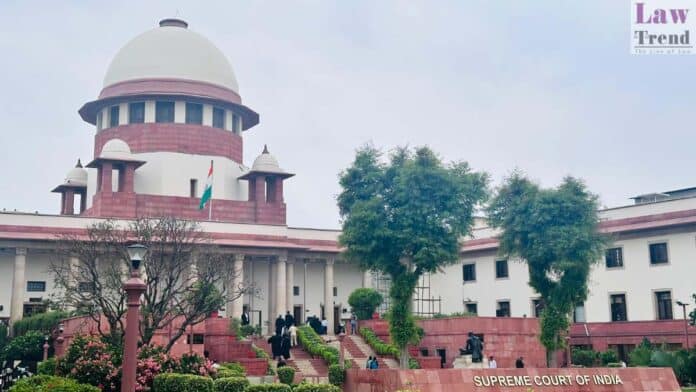The Supreme Court Bench comprising Justice Rajesh Bindal and Justice Manmohan has held that when school records or reliable certificates are unavailable or suspected to be tampered with, courts may rely on medical determination of age with a margin of error of two years on the lower or higher side. Applying this principle in a case where the incident occurred over 35 years ago, the Bench granted the benefit of juvenility to an appellant whose age was determined to be 19 years by an ossification test.
Additionally, considering the long passage of time since the incident in 1988, the Court modified the life imprisonment sentence of the remaining three convicts to a fixed term of 14 years.
Background of the Case
The appeal challenged the judgment of the Patna High Court dated December 14, 2017, in Criminal Appeal (DB) No. 374 of 1993. The Trial Court (Additional Sessions Judge I, Gaya) had originally convicted eight accused persons for offences punishable under Sections 302/149 (murder with common object) and 323/149 (voluntarily causing hurt) of the Indian Penal Code, 1860, sentencing them to rigorous imprisonment for life.
During the pendency of the appeal before the High Court, the cases against three accused—Genda Pandit, Kauleshwar Pandit, and Ramji Yadav—abated due to their deaths. The High Court subsequently dismissed the appeal, confirming the conviction and sentence of the remaining accused.
Arguments of the Parties
Plea of Juvenility: Before the Supreme Court, Appellant Nos. 1 and 2, Umesh Yadav and Ganesh Yadav (sons of Jitan Yadav), raised a claim of juvenility for the first time. They argued that they were less than 18 years of age on the date of the incident, August 30, 1988.
Plea on Sentencing: Regarding the merits, the learned counsel for the appellants did not challenge the conviction but pleaded for leniency. It was submitted that the incident occurred “more than three decades back” and there were “no complaints against the appellants during their period of custody.” Citing the Supreme Court’s decision in Shiva Kumar @ Shiva @ Shivamurthy v. State of Karnataka (2023), the counsel prayed for the life sentence to be reduced to a fixed term.
State’s Stand: The learned counsel for the respondent-State opposed the plea, arguing that the appellants “do not deserve any leniency in the matter.”
Court’s Analysis
1. Determination of Age: The Two-Year Margin Rule
Since the juvenility plea was raised for the first time, the Supreme Court had directed the Trial Court to conduct an enquiry. The report revealed no documentary evidence for Appellant No. 2, Ganesh Yadav. An ossification test conducted by the Medical Board on March 3, 2020, assessed his age as 19 years.
To adjudicate on how the ossification test results should be treated, Justice Bindal, writing for the Bench, relied on the precedent set in Jaya Mala v. Home Secretary, Government of Jammu & Kashmir (1982). The Court quoted the relevant observation:
“However, it is notorious and one can take judicial notice that the margin of error in age ascertained by radiological examination is two years on either side.”
Applying this legal principle to Ganesh Yadav, the Court observed: “Considering the reports… and law laid down by this Court in the aforesaid judgment, giving benefit of two years to Appellant No.2/Ganesh Yadav from the age determined by the ossification test, he can be said to be 17 years of age on the date of commission of offence.”
Consequently, he was held to be a juvenile at the time of the offence.
However, regarding Appellant No. 1, Umesh Yadav, the Court denied the benefit. The Bench noted that he was admittedly the elder brother of Ganesh Yadav. Since Ganesh’s age was determined to be 19 years (implying 17 years with the margin benefit), the Court reasoned that “the age of Umesh Yadav will be more that.” Thus, he could not be treated as a juvenile.
2. Modification of Sentence
On the issue of sentencing, the Court took note of the fact that the incident occurred more than 35 years ago. It further observed the advanced age of the other appellants—Appellant No. 3, Baleshwar Pandit (67 years), and Appellant No. 4, Muneshwar Pandit (59 years).
The Court held: “…in our opinion, the sentence awarded to the three of them can be modified to a fixed term of 14 years of actual imprisonment.”
Decision
The Supreme Court disposed of the appeal with the following directions:
- Appellant No. 2 (Ganesh Yadav): Declared a juvenile. As per Section 18 of the Juvenile Justice (Care and Protection of Children) Act, 2015, the maximum detention is 3 years. Since he had already served over 8 years, the Court ordered that “he deserves to be released immediately unless required in any other case.”
- Appellant Nos. 1, 3, and 4 (Umesh Yadav, Baleshwar Pandit, Muneshwar Pandit): Conviction upheld, but the sentence of life imprisonment was modified to a “fixed term of 14 years of actual imprisonment.”
- Appellant No. 5 (Jitan Yadav): The Court noted his appeal had already been dismissed on May 11, 2018.
The judgment of the High Court was modified accordingly.
Case Title: Umesh Yadav & Ors. v. The State of Bihar Case No: Criminal Appeal No. 1072 of 2018 Coram: Justice Rajesh Bindal and Justice Manmohan







